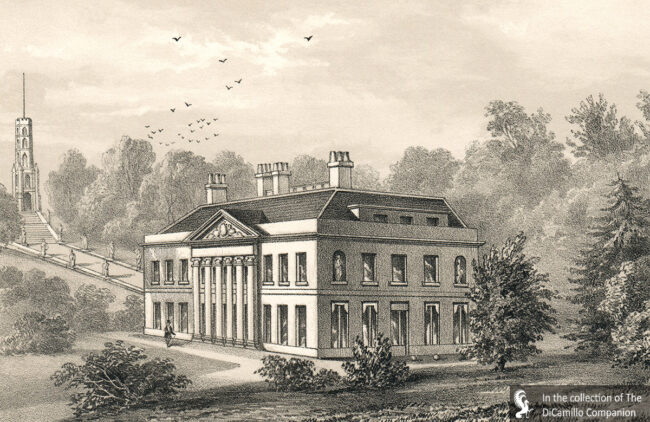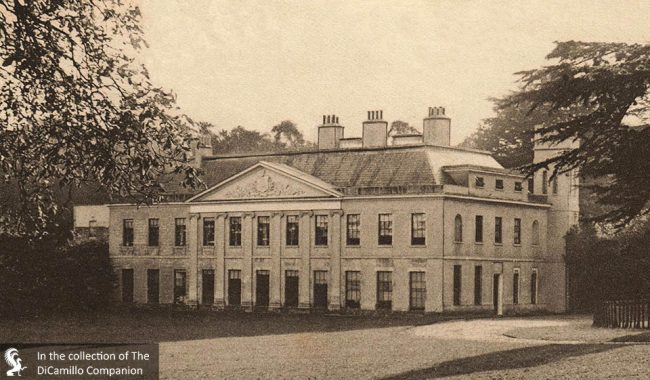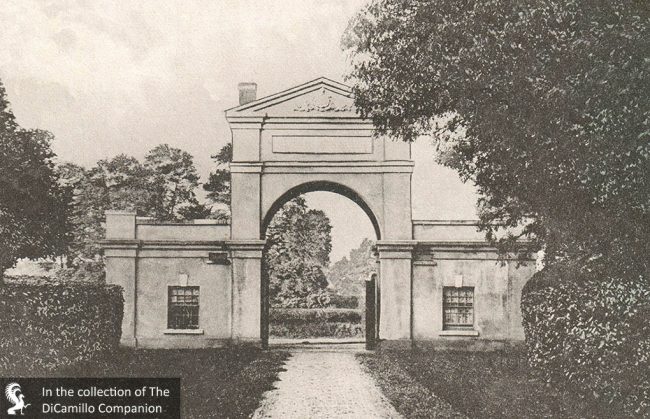
An 1853 lithograph of the house from Burke's "A Visitation of the Seats and Arms of the Noblemen and Gentlemen of Great Britain"

The house from a 1910 postcard

Blandford Lodge from a 1912 postcard
Earlier Houses: There were probably a number of earlier houses on, or near, the site of the current house, including a Medieval manor house (which was listed in the "Domesday Book") and a Tudor house (elements of which may have been incorporated into the current house).
Built / Designed For: Sir Walter II Erle
House & Family History: Built by the Erle family in the 17th century, Charborough remains owned by the Plunkett-Ernle-Erle-Drax family today. In 1686 Col. Walter II Erle hosted at Charborough a meeting to plan the overthrow of the king, James II, and the installation his daughter, Mary, and her husband, William of Orange, as the new monarchs. Two years later the Glorious Revolution, which likely began at Charborough, had occurred. An 18th century owner of Charborough, Henry Drax, keeper of the privy seal, was the secretary to Frederick, Prince of Wales, for whom he built a new wing for a 1741 visit by the prince. Charborough House, which was significantly enlarged and altered during the first part of the 19th century, incorporates stone and timber from Corfe Castle. The house is particularly noted for the Baroque wall and ceiling murals on the great staircase. Created by James Thornhill, a Dorset native famous for his painting on the inside of the dome of St. Paul’s Cathedral, London, the Charborough murals focus on the themes of Heaven and the Triumph of Love as illustrated by the Contest of Beauty and the Rape of Helen (there are similar murals by Thornhill at Sherborne House, Dorset). Charborough has a long history with enslaved people. Much of the wealth that built Charborough derived from the Drax Hall Estate, a 600-acre sugarcane plantation in Barbados that remains owned by the family today. British settlers arrived in Barbados in February of 1627; among them was James Drax, who, by the 1640s, realized that planting sugar instead of other crops resulted in enormous profits. Later called “white gold,” the cultivation and harvesting of sugar, a labor-intensive and dangerous crop, was pioneered by Drax on his Barbados plantation. Using African slave labor, the Drax Hall Estate developed into the largest plantation in Barbados, an operation that produced vast amounts of sugar and money. The introduction of sugar slavery in the New World changed everything for the European powers. In their 2010 book, "Sugar Changed the World: A Story of Magic, Spice, Slavery, Freedom, and Science," Marc Aronson and Marina Budhos summed it all up: “The true Age of Sugar had begun—and it was doing more to reshape the world than any ruler, empire or war had ever done.” Historian Hilary Beckles estimated that close to 30,000 enslaved African men, women, and children died on the Drax Caribbean plantations over 200 years (the family also once owned slave plantations in Jamaica). In the early 19th century John Samuel Wanley Sawbridge Erle-Drax owned 189 slaves on his plantation in Barbados, for whom he received £4,293 (approximately £3.6 million in 2019 values using the labour value commodity index) in compensation under the 1833 Slavery Abolition Act for the loss of his slaves. Charborough Park appears as the fictional Welland House in Thomas Hardy's 1882 novel "Two on a Tower." In the 20th century the amazingly named Admiral Sir Reginald Aylmer Ranfurly Plunkett-Ernle-Erle-Drax was the owner of the Charborough; he was a friend of Ian Fleming, who supposedly modeled Hugo Drax, James Bond's villain-opponent in Fleming's 1955 novel "Moonraker," on the admiral.
Collections: On September 30, 2002 Lawrences of Somerset auctioned some of the collection of Charborough House.
Garden & Outbuildings: Between 1841 and 1842 John Samuel Wanley Sawbridge-Erle-Drax created at at Charborough one of the longest brick walls in England (using almost two million bricks). The Charborough Park Estate today is one of the largest estates in Dorset.
Architect: John Nash
Date: Circa 1810John Bernard (J.B.) Burke, published under the title of A Visitation of the Seats and Arms of the Noblemen and Gentlemen of Great Britain and Ireland, among other titles: Vol. II, p. 166, 1853.
Country Life: LXXVII, 322, 1935.
Title: Time (magazine)
Author: NA
Year Published: NA
Reference: Jul 24, 2023, pgs. 26-28
Publisher: New York: Time
ISBN: 0040-781X
Book Type: Magazine
Title: Country Houses of Dorset
Author: Oswald, Arthur
Year Published: 1935
Reference: pgs. 75-76
Publisher: London: Country Life Ltd.
ISBN: NA
Book Type: Hardback
Title: Biographical Dictionary of British Architects, 1600-1840, A - HARDBACK
Author: Colvin, Howard
Year Published: 2008
Reference: pg. 736
Publisher: New Haven: Yale University Press
ISBN: 9780300125085
Book Type: Hardback
House Listed: Grade I
Park Listed: Grade II*
Current Seat / Home of: Richard Grosvenor Plunkett-Ernle-Erle-Drax
Past Seat / Home of: SEATED AT EARLIER HOUSES: Walter I Erle, until 1581; Thomas Erle, 1581-97. SEATED AT CURRENT HOUSE: Col. Sir Walter II Erle, until 1665; Lieutenant-General Thomas Erle, 1665-1720. Sir Edward Ernle, 3rd Bt., 1720-29. Henry Drax, 1729-55; Thomas Erle-Drax, 1755-89; Edward Erle-Drax, 1789-91; Richard Erle-Drax-Grosvenor, 1791-1819; John Samuel Wanley Sawbridge-Erle-Drax, until 1887; Ernle Elizabeth Louisa Maria Grosvenor Plunkett Ernle-Erle-Drax, Baroness Dunsany, until 1916; Admiral The Hon. Sir Reginald Aylmer Ranfurly Plunkett-Ernle-Erle-Drax, until 1967; Henry Walter Plunkett-Ernle-Erle-Drax, 1967-2017.
Current Ownership Type: Individual / Family Trust
Primary Current Ownership Use: Private Home
House Open to Public: Limited Access to Grounds Only
Phone: 01258-857-204
Email: [email protected]
Website: http://www.charborough.co.uk
Historic Houses Member: No